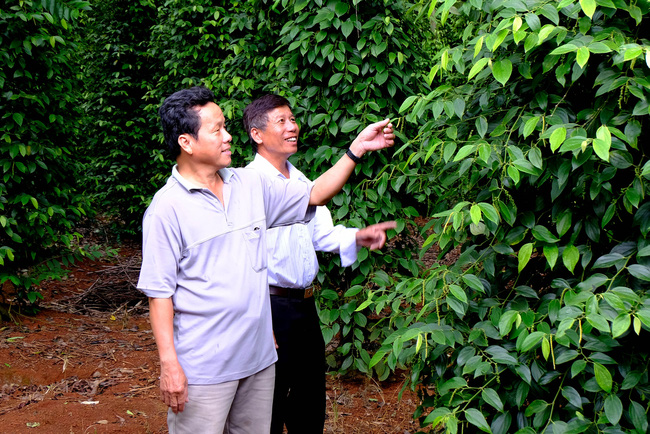Ba Ria – Vung Tau: Organic pepper production for export
To
develop clean and safe raw material areas, many farming households and
cooperatives in Chau Duc district have linked up to produce organic
pepper, targeting the export market.
Choose clean production direction
Mr.
Tran Xuan Tho, a farmer in Son Lap village (Son Binh commune) has been
growing pepper for decades. Thanks to organic farming, 8.5 sao of pepper
grown on acacia and cotton trees has brought a stable annual income for
his family.
In the 2024 pepper crop, Mr. Tho harvested nearly 4 tons of dry pepper. “ In
the past 3 years, I have switched to organic care, reducing investment
costs. Although the yield is not high, in return, the pepper plants grow
well and sell for a higher price. Previously, many growers used
excessive chemicals in traditional farming, leading to many consequences
for the environment, the land quickly became barren and affected human
health ,” said Mr. Tho.
Mr. Bui Thanh Hung, in Song Cau village (Nghia Thanh commune) also clearly saw the value and effectiveness of organic pepper cultivation
. In the 2024 crop, despite being affected by prolonged hot weather,
the 6-sao pepper garden grew well and harvested 2.5 tons of dry beans.
Mr. Hung said that although the yield was not as good as traditional
cultivation, there was no crop failure, the plants were not sick, and
did not weaken after harvest.
“ I
see that organic farming has many benefits. When we do organic farming,
we do not use chemicals that are harmful to human health. Regarding
plants, we do not use toxic chemicals, so the soil remains fertile and
lush for plants to grow ,” Mr. Hung added.
According
to Mr. Than Xuan Dong, Vice Chairman of the Farmers’ Association of
Chau Duc district, the conversion to clean and organic farming methods
has partly restored the position of pepper plants. Through the actual
inspection of the Farmers’ Association of the district, currently most
households cultivating clean and organic pepper standards have stable
incomes, are committed to long-term cultivation and can live well from
this crop.
Sustainable Development Link
Recently,
through the formation of cooperative models and cooperatives for
sustainable pepper production, many participating households have had
the opportunity to exchange and access techniques for growing and caring
for pepper plants in an organic manner. In particular, when
participating in the models, farmers will ensure a source of output for
products and stable prices.
Mr.
Ngo Xuan Son, Chairman of the Board of Directors and Director of the
Comprehensive Rich Organic Cooperative, shared that the majority of
members of the cooperative are farmers who have been growing pepper for
many years. Thanks to the propaganda and mobilization of the District
Farmers' Association, 7 farmer households in the district, Dong Nai
province and Ho Chi Minh City have joined forces to produce organic
pepper, with the desire to increase product value and move towards
sustainable production.
Since
its inception, the cooperative has zoned off nearly 50 hectares of
adjacent farming households in Xuan Son, Son Binh and Suoi Rao communes
to form a raw material area. Participating households must comply with
technical instructions and strict supervision by the cooperative's
environmental control board.
According
to Mr. Do Chi Khoi, Head of the Department of Agriculture and Rural
Development of Chau Duc district, the whole district has 5,077 hectares
of pepper; the harvested area is 4,928 hectares, the output reaches
9,856 tons of dry pepper/crop.
Chau
Duc district sets the goal of forming organic pepper production areas
by 2025, creating a source of high-quality agricultural products;
forming production chains associated with the consumption of organic
agricultural products, meeting domestic consumption and export needs.
According
to Mr. Son, before establishing the cooperative, he and some members
had more than 5 years of organic pepper production. “ For
many years, I have not abused chemical fertilizers and pesticides to
take care of the pepper garden, but mainly used biological products to
help prevent nematodes and root-damaging fungi. Since producing
organically, well water is no longer polluted as before. The rate of
dead plants in the garden has decreased to only 3-5%; the cost of buying
fertilizer has also decreased compared to before… ”, Mr. Son added.
According
to the plan, in the 2025-2027 period, the cooperative will have a raw
material area of 100 hectares of pepper; in the 2028-2030 period, the
cooperative will produce about 500 hectares of pepper in an organic
direction. Currently, the cooperative has signed a contract to purchase
organic pepper output with Organics More Company. In addition, in the
district, there are also Phuc Thinh Import-Export Investment Joint Stock
Company (PTEXIM CORP), Harris Freeman Vietnam Company Limited, which
are cooperating to purchase dry pepper from farmers in large quantities.
According to Ba Ria - Vung Tau Newspaper













